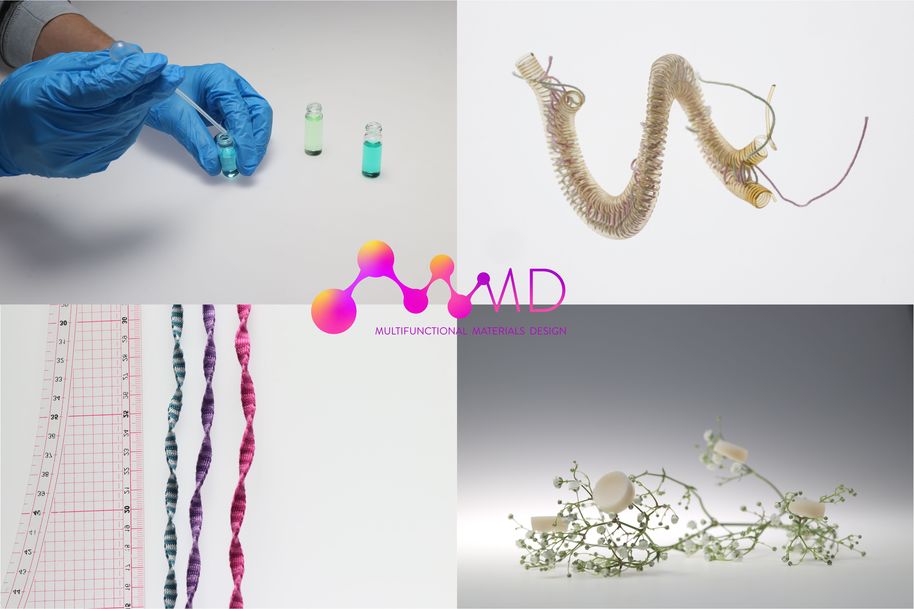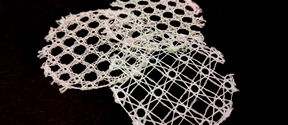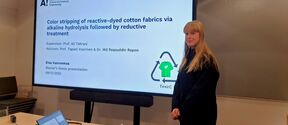The MMD research group is mapping the spaces between disciplines

The Multifunctional Materials Design research group (MMD) led by professor Jaana Vapaavuori focuses on experimental studies of soft materials, as well as inorganic-organic hybrids. The group’s ultimate goal is to combine multiple functionalities in the same material through supramolecular chemistry and designing hierarchical structures.
Since the MMD research group’s formation in 2019, they have embraced cross-disciplinary research and co-creative approaches in their work.
When the pandemic hit in 2020, the MMD group began to seek ways of increasing their unity by organising internal social activities. These include playful “collaboration challenges” between group members as a form of community building and “Philosophical Mondays”, bimonthly discussions of changing topics.
The Philosophical Mondays are an hour-long session that the group organises every second week. Each time, some group members prepare a talk about a topic of their choosing. The intention of the sessions is to highlight different types of frameworks outside of the group’s core research interests that might yield new perspectives.
“We try to keep the sessions as free as possible. If something useful comes out of the discussions, that is great, but the intention is not to force the topics to relate directly to our work”, Vapaavuori says.

Since the MMD group works extensively in-between different fields, the Monday sessions often include discussion about the group’s identity. The topics are determined by the interests of the presenting members.
“One of our sessions dealt with roleplaying and how the experience could be enhanced by using digital fabrics. For instance, we discussed how the concept of roleplaying would change if the dominance of our visual sense could be challenged with fabrics that can engage our other senses. That session was directly related to the group’s work, but not all topics need to be as concrete”, says Vapaavuori.
In another session, the group discussed feminism in the research community – the practice of research, formulation of research topics, and how gender biases skew our understanding of what is recognized as a merit in academia.
“For instance, we have discussed how women played a huge role in the early stages of computer science, and how that part of history has been somewhat ignored. That discussion was specifically about aerospace research, where some of the very early computing was actually done with fabrics. And that work was done by women whose contributions have largely been neglected by the contemporary and current scientific community.”
Breaking out of conventions through free discussion
Vapaavuori says that the goal of the Monday discussions is to prevent the group from settling to their ways, while seeking indirect ways to come up with new ideas.
“If you only have a group of similar people who think in a similar way, and if you have a strict structure which only allows you to think in a certain way, it is necessary to try to break out of these self-enhancing conventions to promote creative thinking.”
Furthermore, Vapaavuori thinks that free discussion is something that the university as a community could offer more, limited resources permitting. More opportunities for discussion would benefit the students as well.
“There is obviously this huge time pressure of finishing your studies and for doctoral students to finish their articles and to graduate. But maybe we could spend just a little bit more time talking about the quality of the students’ time spent at the university as well – how they grew as people, what kinds of experiences they had, did the education open their mind to new ideas, and so on.”
The MMD group collaborates extensively with groups from the other Aalto schools as well. Vapaavuori says that multidisciplinary efforts between the research groups are often instrumental, i.e., the collaboration is based on the sharing of research equipment or facilities. But there is still a lot of potential to learn from other disciplines in a more philosophical sense, to understand different ideas better and come together in creating new ones. The same principle applies to student programmes.
“It’s possible to combine courses from different schools to get the formal education, but if we only value the things that can be directly measured and do not create room for discussion, how are the students going to find their role in the spaces in-between disciplines, and what is the identity of those students who try to work in those spaces?”
Reaching out to different fields and communities outside the university
During the three and some years they have been active, the MMD group have laid a good base for multidisciplinary collaboration. Vapaavuori says they are eager to see what can arise out of their connections.
“Now is the time to explore our ways of cooperation, to try to support the ongoing things so that they reach their full potential”, Vapaavuori says.
The group has been organising an open event in materials engineering twice a year. The idea is to branch out to the public, to have low-key events that could get people with different interests and backgrounds interested or involved in the group’s work.
Part of the group’s process is also to reach out to people from different communities outside of academia as well.
“We have a project that focuses on different types of traditional handicraft methods in order to create modern, actuating, and digital fabrics. In that context, we asked skilled trades people who are not within the sphere of academia to actually visit us, to chat and exchange ideas.”
The group would like to continue inviting different communities of practitioners to visit them, be it handicraft people or, say, musicians and music enthusiasts. The interactions might lead to new knowledge and people are usually happy to be invited to share their views.
“There is a lot of hidden knowledge within these different interfaces that is not recognized in an academic sense. People practice their own art or craft form and don’t necessarily think that it might be useful for other causes as well. There is a lot of knowledge and practices that are disappearing as generations pass. We want to reach out to them while we still have time”, Vapaavuori says.
Multifunctional Materials Design
Group led by Professor Jaana Vapaavuori

Read more news

Learning Centre opening hours during Christmas and year-end holidays
Thank you for the past year and have a wonderful holiday season!
Smart textiles are reshaping our understanding of materials – and interspecies communication
The PAST-A-BOT research project, funded by the European Research Council (ERC), is developing soft, intelligent textiles that could one day function as rescue robots, sound-sensing agricultural fabrics, or assistive clothing. At the same time, the project aims to rethink the way we approach materials research.
Master’s student showcases efficient color stripping of cotton fabrics
On December 9, master’s thesis student Elsa Vuorenmaa from the Textile Chemistry Group presented the results of her research on color stripping of reactive-dyed cotton fabrics.






